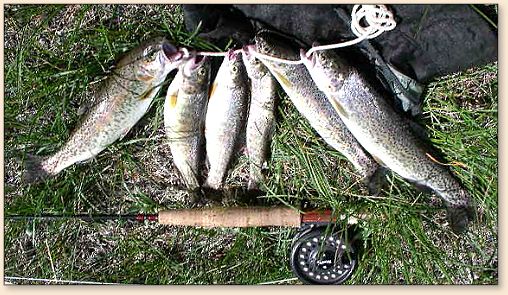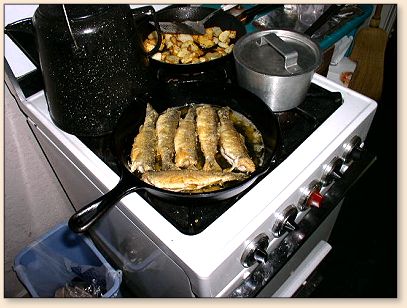|
My friend June is among the handful of hardcore
paddlers I go canoe camping with on the Kansas
River. A substitute schoolteacher nine months
of the year, in 2003 she had the good fortune to
land a summer volunteer job with the U.S. Forest
Service in Idaho's Sawtooth National Recreation
Area. Summer of 2003 marked the second time June
worked there, so she was getting familiar with many
of the indigenous plants and animals.
Before she left for Idaho, I told her of my plan
to drive to California in August and visit my oldest
son, and while there I'd be giving trout fishing a
try in the Sierra streams. Hearing this, June
suggested that on my drive home I take a northern
route up through central Idaho and stop by Sawtooth
NRA for a few days and try for trout in the East Fork.
She'd heard the fishing was pretty good, but had
never tried it herself.
Researching Idaho fishing regs before heading west,
I learned that the East Fork is home to brook trout.
Which meant nothing to me until I read on and saw
that the creel limit on brookies was in the neighborhood
of 25 fish per day. I took that to mean one of two
things: either brookies are prolific to the point of
being nuisance fish, or else Idaho's wildlife agency
has a management reason for wanting anglers to kill
large numbers of this species daily.
No tourist could be a more novice trout fisher; I
would not contribute much to Idaho's brookie control
program if they indeed had one. Still, the idea of
keeping so many fish a day was enticing. The idea
became irresistible after further research informed
me that brookies are the best tasting of all the
trout. A side trip to the East Fork now began
appealing to my stomach as much as my spirit. I'd
been on enough canoe trips with June to know how
fine a cook she is. If I couldn't figure out what
to do with a stringer of brookies, she'd know!
So in late August there I was, wading nervously into
the chilly waters of the upper East Fork of the Salmon.
Tell you what: when you've grown up fishing gentle
Midwest prairie streams, the very slowest mountain
stream in the West looks like a rocket ship. The
water rushes at you then races downstream at
bewildering speed. Keeping your feet planted on
the slippery rocks is difficult at all times, even
wearing felt boots in water only ankle deep.
Before leaving Kansas and again in California, I'd
picked the brains of many fly shop employees for
advice on how to catch trout. With their good help,
I arrived in Idaho with some flies plus a few basic
tactics to try. Still, as I stood in the river
stripping line off the reel prepping for my first
cast, with June standing on the bank watching
expectantly and the water rushing by in a blur,
I felt like a monkey flying a space ship.
First hard lesson the East Fork taught me is that
even a doped-up Elk Hair Caddis, if cast into waves,
immediately becomes a submarine whose underwater
location is Top Secret. My line might have indicated
the fly's whereabouts had the East Fork not been so
busy express shipping both items to the Pacific coast.
I'd positioned myself at the inside arc of a 20-ft.
wide curving run. Getting no hits in the swifter
water opposite, I targeted the shallower, slightly
slower but relatively smooth water of the inside
eddy. Just like I do in Kansas when fishing a moving
stream, I sent my cast into the "edge habitat" between
the main current and the eddy, hoping the slower eddy
water would float my Caddis down the length of the
current break. Which it did, much to the pleasure
of a 6-inch brook trout!
This first afternoon, June had been tour driving me
around the valley when we stopped to fish this spot.
I'd forgotten to put my cooler in the bed of her
truck. Unable to protect my catch from spoilage,
we wouldn't be having trout for supper tonight.
So this was "experimental fishing."
But next morning, I got up early and hiked
downstream from the cabin, where I found a
classic straight-ahead riffle with a calm,
wide pool below the drop. I waded into the
shallow tail of this pool and began fan
casting my way slowly upstream into deeper
water, this time using a Parachute Adams fly
because its little white topknot shows up on
the river like a highway flare. Before long
I felt myself starting to relax, adjusting to
the quick cast-and-retrieve tempo demanded on
mountain streams.
What relaxed me even more was that I was catching
fish and getting lots of strikes. But losing my
grip on netted trout, too - an education in itself.
With five keepers on my stringer and it's only 8 a.m.,
I couldn't help fluffing up: Idaho Brookie Control
had found their man!
About then, June appeared on the high bank overlooking
the pool. Spotting the fish on my stringer, she
nervously and apologetically told me that she wasn't
sure they were brookies; they could be rainbow trout.
If they were rainbows, she wasn't sure it was legal
to keep them. I was in no position to argue; many
weeks had passed since I last looked at photos of
brook trout. I sure wanted these fish to be brookies,
but suddenly I was afraid of getting arrested as a game
violator. So to be safe I released the fish, watched
them zoom away to safety, then quit fishing.
Back at the cabin, we looked at June's Audubon book
and it was clear that the fish I'd caught the afternoon
before, plus the five morning fish, were all rainbow
trout. The question now was: is it legal to keep East
Fork rainbows for food? If so, how many?
That afternoon we drove to Clayton and visited a
general store where we got the straight skinny - rainbows
are indeed legal quarry in the East Fork, they were in
season and I could keep six a day. Hearing this,
June felt awful; her concerns that morning had
caused me to release a supper meal of trout when
I needn't have. I told her not to grieve: the
morning's luck had me confident that I might catch
us some more.
Besides, had she not intervened I would never have
made a special trip down the valley to acquire more
Parachute Adams flies (I'd brought just one.).
It's 80 miles and a minimum 4 hours over rough
road from her Forest Service cabin to Clayton
and back. I would have invented an excuse not
to go.
So everything worked out. I camped at June's
station four days, and three days we had rainbow
for supper. I never caught a brookie the whole
time I was there; turns out they live in the higher
tributaries, in back country areas I wasn't geared
to reach. And may I say that if brookies really
are the best eating of all trout, then rainbows
aren't far behind. I gutted and headed each one,
June rolled them in flour and cracker crumbs and
fried them in olive oil. Salt and pepper and a
squeeze of lemon were the only seasonings. Excello!
Two noteworthy highlights happened the last day
of my visit. The first took place at a riffle
that runs crosses the river on the bias. I hadn't
got a single hit in the long pool below this riffle.
After giving up I exited the pool, walked up the
bank and started wading across the riffle so I
could fish the next pool upstream.
Halfway across I stopped and glanced back at the
pool I'd just abandoned. For some reason I was
seized by the idea of casting into the pool then
dragging my fly upstream against the current into
the whitewater at the bottom of the riffle. All
my life, I've read that one of the cardinal rules
of trout fishing says you NEVER allow line drag
to contaminate the natural drift of a dry fly.
Deliberately pulling a dry upstream might be a
violation of U.S. Code punishable by 10 years
in Leavenworth. Or worse, I might get smoked by
a lightning bolt hurled from the heavens by the
enraged ghost of Isaac Walton.
Aw, what the hell. A Kansas tourist is about to
do something really ignorant; so what else is new?
Maybe the trout fishing spirits will let him off
with only a mosquito bite on the wrist. I made
the cast.
The Parachute landed in the pool, I began stripping
line and the skittering fly never reached the
whitewater foam before the surface exploded
compliments of a 10-inch rainbow-hued torpedo.
I was dumbstruck, but as I threaded this beautiful
keeper onto my stringer an extremely happy thought
occurred to me: "Trout can't read!"

My self-imposed feelings of inadequacy melted away
and I began completely enjoying myself from that
moment on. No longer did I feel compelled to use
the textbook upstream casts and no-drag drifts.
Because rather than fleeing in terror, this wild
Idaho trout had just attacked a presentation that
broke all the rules. Bless his heart!
The second highlight involved the last fish of the
trip. I was working upstream from June's cabin that
afternoon when the valley walls closed in, dead-ending
me at a whitewater rapid boulder garden. Below the
steep drop laid a short but very deep pool, judging
by the color of the water. This pool was also narrow,
funneling the river's entire volume through with
considerable force and turbulence. No chance for
a wading approach here.
Creeping to the side of the pool, I stayed low behind
a huge boulder. My first attempts were with a Parachute
Adams. No takers. No surprise, either; my fly could
drift but a couple of seconds before getting washed
out the tail of the pool. No takers, but this deep
hole had Keeperville written all over it. So...what
to do?
I clipped off the Parachute and tied on a #10
flashback Hare's Ear nymph. This would be my
first use of a nymph. I threw it into the rapid
just above the drop so that it would start sinking
before it got swept over. I wanted it to go deep.
An instant later I could see from my line angle
that the drop had indeed taken it far down into
the hole. Halfway through, my rod tip got yanked
hard and the line moved off to the side - definitely
a fish. Maybe a big trout or maybe a small one the
current was helping, but I was in trouble. After
many rod tip countermoves to keep the fish from
rubbing my tippet against the rocks, I netted a
12-inch rainbow Big Boy - fish #6, and my day was
done.
I was so impressed by how viciously that last trout
took a nymph that when I left Idaho that Hare's Ear
nymph stayed on my leader. As an experiment, a week
after getting home I tried it on panfish so that
Douglas State Fishing Lake's bluegill and crappie
could express their view regarding its worth.
The rest, as they say, is lunch.

But getting back to the title of this story: are
mountain rainbows panfish? Every time I look at
the stovetop photo of a day's limit sizzling in
June's cast iron skillet, I still don't know if
the category applies in the correct scientific
sense. My taste buds can offer only a layman's
opinion, and no doubt many books would disagree.
~ Joe riverat@sunflower.com
About Joe:
 From Lawrence, Kansas, Joe is a former municipal and
federal police officer. In addition to fishing, he hunts
upland birds and waterfowl, and for the last 15 years
has pursued the sport of solo canoeing. On the nearby
Kansas River he has now logged nearly 5,000 river miles
while doing some 400 wilderness style canoe camping
trips. A musician/singer/songwriter as well, Joe's
'day job' is with the U.S. General Services Adminstration.
From Lawrence, Kansas, Joe is a former municipal and
federal police officer. In addition to fishing, he hunts
upland birds and waterfowl, and for the last 15 years
has pursued the sport of solo canoeing. On the nearby
Kansas River he has now logged nearly 5,000 river miles
while doing some 400 wilderness style canoe camping
trips. A musician/singer/songwriter as well, Joe's
'day job' is with the U.S. General Services Adminstration.
Joe at one time was a freelance photojournalist who wrote the
Sunday Outdoors column for his city newspaper. Outdoor
sports, writing and music have never earned him any money,
but remain priceless activities essential to surviving the
'day job.'
|



 From Lawrence, Kansas, Joe is a former municipal and
federal police officer. In addition to fishing, he hunts
upland birds and waterfowl, and for the last 15 years
has pursued the sport of solo canoeing. On the nearby
Kansas River he has now logged nearly 5,000 river miles
while doing some 400 wilderness style canoe camping
trips. A musician/singer/songwriter as well, Joe's
'day job' is with the U.S. General Services Adminstration.
From Lawrence, Kansas, Joe is a former municipal and
federal police officer. In addition to fishing, he hunts
upland birds and waterfowl, and for the last 15 years
has pursued the sport of solo canoeing. On the nearby
Kansas River he has now logged nearly 5,000 river miles
while doing some 400 wilderness style canoe camping
trips. A musician/singer/songwriter as well, Joe's
'day job' is with the U.S. General Services Adminstration.